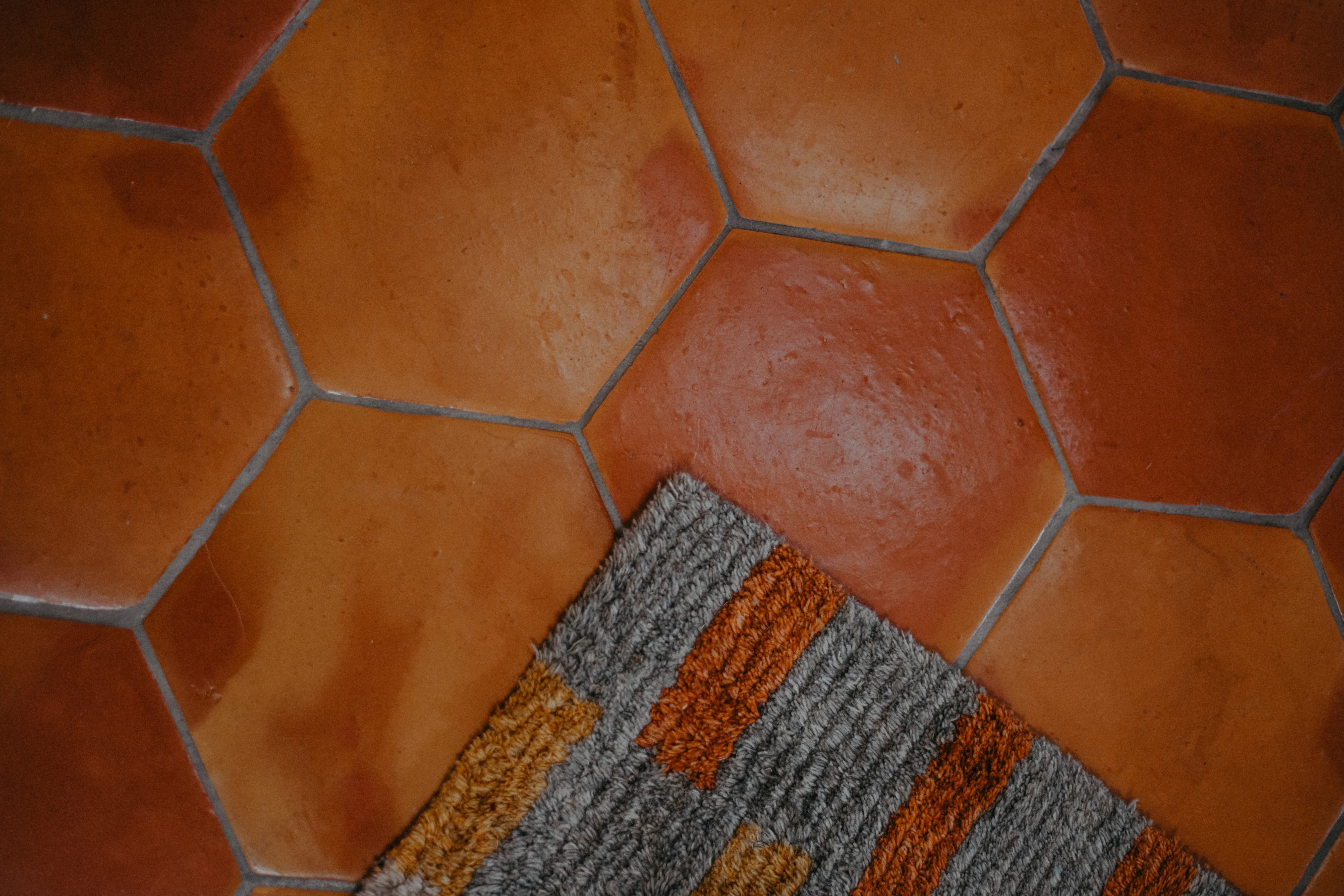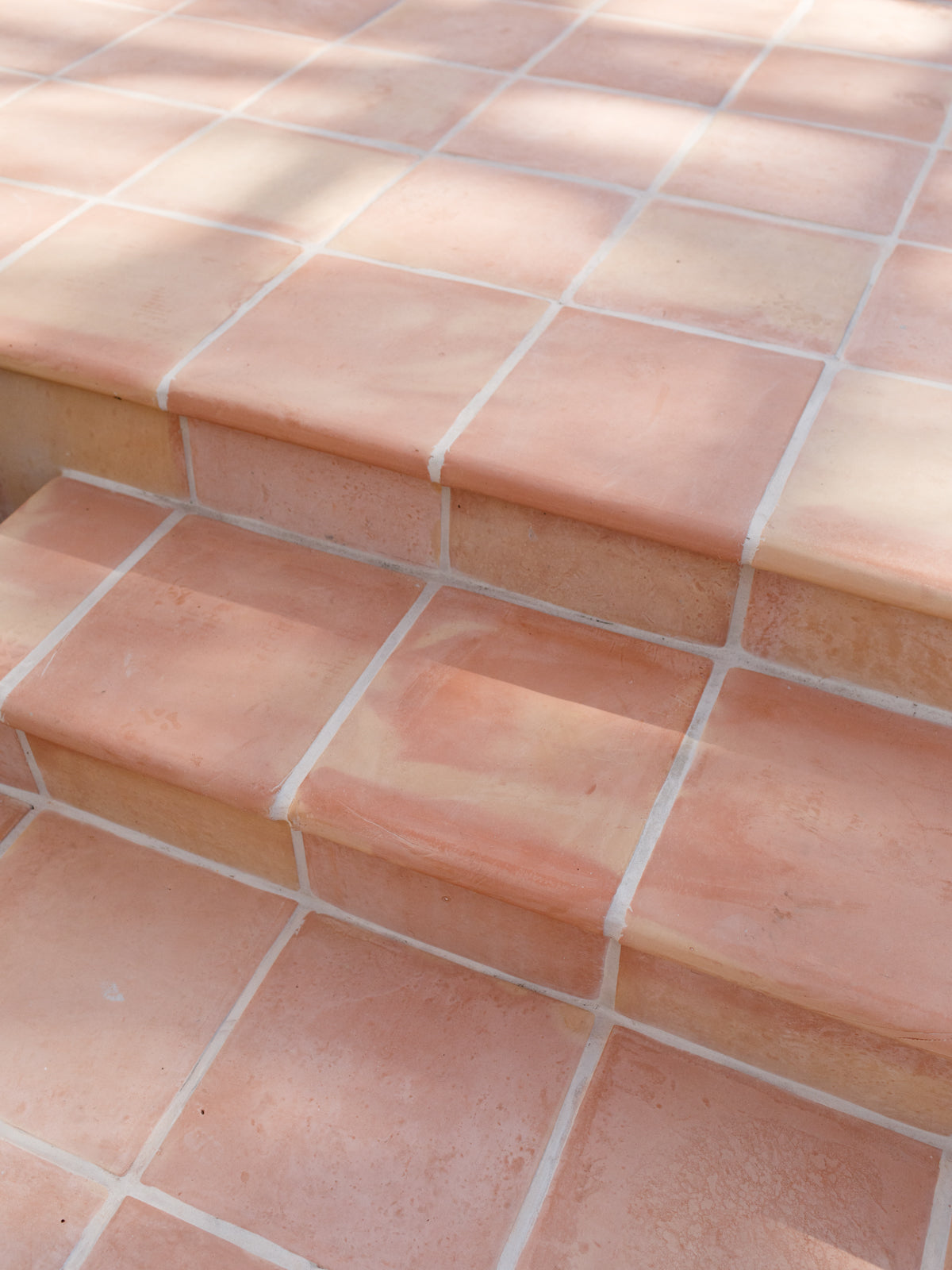By Clay Imports
Handmade Saltillo tiles are a beautiful and natural flooring option. If you’re working with unsealed Saltillo, it’s critical to seal the tile properly before grouting or exposure to moisture. This prevents permanent staining, protects the terracotta, and creates a gorgeous, long-lasting glossy finish.
While we recommend working with a professional tile installer, if you're going the DIY route, this step-by-step guide is here to help you achieve the best results.
- Why do I need to seal Saltillo tile?
- When do I need to seal Saltillo tile?
- What materials do I need to seal Saltillo tile?
- How long does it take Saltillo tile sealer to dry?
Why Does Saltillo Tile Need to Be Sealed?
Saltillo tile is made from natural clay and fired at low temperatures. That means:
- Extremely porous: It absorbs liquids, dust, and oils rapidly.
- No surface glaze: Unlike porcelain or glazed ceramic tile, there's nothing to repel moisture or stains.
- Handmade variation: Each tile has unique textures and tones, which sealer can help enhance and protect.
Unsealed Saltillo tile will permanently stain if exposed to grout, water, or debris before sealing. That’s why we only offer our Saltillo tiles sealed, but if you opted for unsealed tile, careful sealing before installation is non-negotiable.
When Should I Seal Saltillo Tile?
Sealing strategy depends on the size and nature of your project:
Small spaces (<100 sq. ft.) | Pre-seal all tiles before installing them.
Larger spaces (>100 sq. ft.) | It’s common to set the tile first, then seal it before grouting. Just make sure the tile remains protected from spills, footprints, or contaminants during and after setting.
Never grout unsealed tile. Grout will seep into the pores and stain the surface permanently.
What materials do I need to seal Saltillo tile?
To achieve a traditional glossy finish, gather the following:
Sealant System
- Rexcel Oil-Based Sealer – 1 gallon covers ~100 sq. ft.
- Lacquer Thinner – Used to dilute the sealer for better absorption.
Application Tools
- Clean 5-gallon plastic buckets (1 or 2)
- Clean wooden mixing stick
- Large yellow grout sponges (buy extras in case they degrade)
- Rubber gloves
- Safety goggles
- Respirator or face mask (optional but recommended for ventilation)
- Clean rags
Step-by-Step: Sealing Unsealed Saltillo Tile
Always experiment using your Saltillo tile sealer on a small sample area or uninstalled tile before applying it to a large area.
Prepare Your Space | Make sure that you are working in a well-ventilated area and that you are wearing the appropriate safety gear.
- Ensure the tiles are completely dry and free from dust or residue.
- Lay out your tiles on a clean surface if sealing before installation.
- Use a test tile to get familiar with the absorption rate and finish.
Mix the Sealer | Mix in a clean 5-gallon bucket, combine:
- 1 gallon Rexcel Sealer
- ½ gallon lacquer thinner
- Mix thoroughly with a wooden stick. This dilution helps the sealer absorb smoothly into the porous tile.
- Note: Mix only what you’ll use in 30–60 minutes. Sealers can become tacky if left sitting too long.
Apply the First Coat
- Dampen a yellow grout sponge in the sealer mixture.
- Let excess drip off into the bucket .Do not squeeze the sponge or let it drip on the tile.
- Lightly drag the sponge across one tile at a time in straight, even lines.
- Overlap strokes slightly to ensure complete coverage.
- Do not press too hard and let the sealer absorb into the tile without pooling.
- If sealer drips or puddles on the surface, it may leave dark, glossy blotches that don’t cure evenly.
- Continue applying to each tile individually.
- Watch for debris or footprints. Sealing over them will lock them into the tile.
Let the First Coat Dry
- Allow the first coat to dry for at least 1 hour before applying a second.
- The first coat will absorb quickly.
- As it dries, the surface may look matte or uneven, this is expected.
Apply the Second Coat
- Use a fresh sponge or clean the first one if still intact.
- Apply the second coat just like the first, using light, even strokes.
- You may notice some slight streaking, don’t worry. With proper application, this will begin to even out in later coats.
- Wait 1 to 2 hours for the second coat to dry.
Test for Dryness
- Before proceeding with the third coat:
- Use a clean sponge to lightly touch the tile surface.
- If the sponge sticks or pulls, the tile isn’t ready, wait longer.
- If it glides smoothly, the tile is ready for the next coat.
Apply the Third Coat
- Apply the third coat as before.
- This coat should begin to even out the sheen and reduce streaks.
- After drying, evaluate the finish:
- If glossy and uniform, you’re done.
- If streaky or inconsistent, proceed with additional coats.
(Optional) Apply Additional Coats
- You may apply up to 5 thin coats total.
- Always allow proper dry time between coats.
- Stop once the surface has a consistent, glossy sheen without streaks or dull spots.
Dry Time
- Touch dry: A few hours
- Walkable: 12–24 hours (light traffic only)
- Full cure: Up to 72 hours
- Avoid moisture or cleaning during this period.
After Sealing: What’s Next?
Once sealing is complete and fully cured:
- Install the tile, using a thin-set mortar appropriate for Saltillo.
- Grout the joints, using your preferred grout type.
- Apply a topcoat sealer after grouting to protect both the tile and grout lines.
We have a full installation guide available: Installation Guides for proceeding with the next steps. We highly recommend our Clay Care topcoat products, which are specifically formulated for our Saltillo tiles. These help preserve the finish and prevent staining, especially in high-traffic or wet areas.
Final Tips
- Change sponges frequently, once they begin to deteriorate, they can leave behind foam or fibers that will stick to the tile.
- Avoid rushing. Applying thick or sloppy coats can lead to blotchiness and uneven shine.
- If working in hot, dry climates, your dry time between coats may be shorter, adjust accordingly.
- Always test your process on a sample tile before committing to the entire batch.
Questions? Need Help?
Reach out anytime at contact@clayimports.com. Our team is happy to help troubleshoot or offer product recommendations tailored to your project.
Because installation techniques can significantly impact the performance and final look of your tile, Clay Imports does not warranty tile not purchased fro us, nor once it has been installed. Please inspect all tile before installation. This guide is intended as a general reference, consult with a professional installer for project-specific recommendations.




 Share
Share
 Pin it
Pin it












